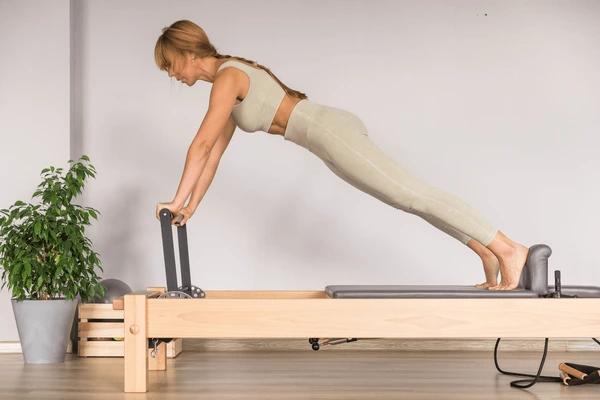Using a Pilates reformer machine properly is crucial to ensure a safe and effective workout. Here are general guidelines for using a reformer, but keep in mind that these may vary slightly depending on the specific model and design of your machine. If you are new to Pilates or the reformer, it's highly recommended to work with a certified Pilates instructor to learn proper techniques and form. Here's a basic guide to get you started:
1. Warm-Up:
- Start with a brief warm-up to prepare your body for the workout. This can include gentle movements, such as leg swings, arm circles, and spinal stretches.
2. Adjust the Springs:
- Choose the appropriate resistance level by adjusting the springs. Beginners typically start with lighter resistance and gradually progress to heavier settings as they gain strength and proficiency.
3. Body Alignment:
- Pay attention to your body alignment throughout the workout. Maintain a neutral spine, engage your core muscles, and keep your shoulders relaxed.
4. Foot Placement:
- Position your feet securely on the foot bar or footrest, depending on the exercise. Ensure that your feet are aligned and your weight is distributed evenly.
5. Breathing:
- Practice the Pilates breathing technique: inhale through the nose, expanding the ribcage, and exhale through pursed lips, engaging the deep abdominal muscles.
6. Start with Foundational Exercises:
- Begin with foundational exercises to familiarize yourself with the machine. Exercises like footwork, leg presses, and pelvic curls are often suitable for beginners.
7. Progress Gradually:
- As you gain strength and confidence, progress to more challenging exercises. Consult with a qualified instructor to ensure proper form and technique as you advance.
8. Smooth and Controlled Movements:
- Perform all exercises with smooth, controlled movements. Avoid using momentum, and focus on engaging the targeted muscles throughout each exercise.
9. Mind-Body Connection:
- Concentrate on the mind-body connection. Be aware of the sensations in your body, and focus on precision and control in your movements.
10. Use Accessories Safely:
- If using accessories such as straps, ropes, or the foot bar, ensure that they are securely attached. Follow proper techniques and guidelines for each accessory.
11. Full Range of Motion:
- Strive for a full range of motion in each exercise without compromising form. This helps improve flexibility, strength, and coordination.
12. Listen to Your Body:
- Pay attention to how your body feels during and after each exercise. If you experience pain (not to be confused with the normal discomfort associated with muscle engagement), stop the exercise and consult a professional.
13. Cool Down:
- Finish your workout with a cool-down, incorporating stretches and movements to help relax your muscles.
14. Maintenance and Care:
- After your workout, wipe down the reformer, check for any loose bolts or parts, and store it properly according to the manufacturer's recommendations.
Remember, proper form is more important than the number of repetitions or the resistance used. If possible, consider taking a few sessions with a certified Pilates instructor to get personalized guidance on your technique and form. This will help you get the most out of your Pilates reformer workouts while minimizing the risk of injury.





Share:
How to assemble a Reformer machine?
A Comprehensive Guide to Alleviating Lower Back Pain using Pilates